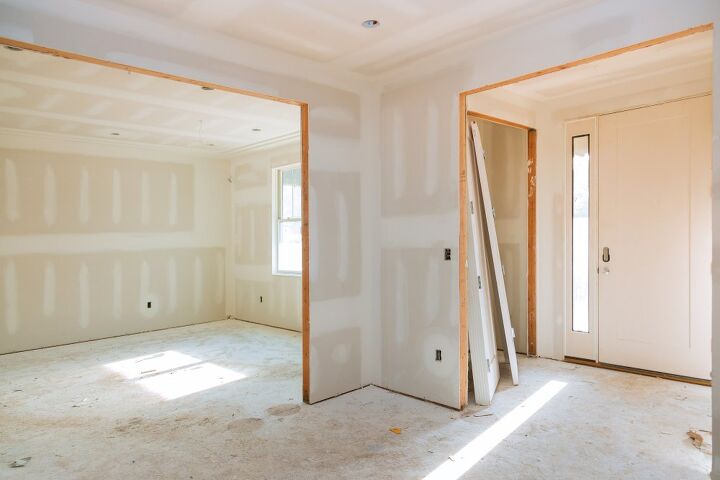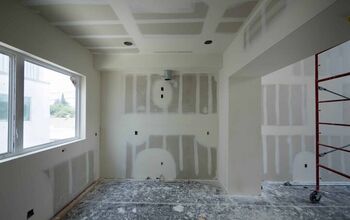Why Is Drywall Hung Horizontally?

Hanging drywall in a home is a big moment. It is when the shape and feel of a house really takes form and the construction site suddenly becomes a home. The drywall phase is a real turning point in home construction, and it involves some careful considerations. After all, you need to decide the type, amount and size of drywall that you need. You even need to decide whether you should hang it vertically or horizontally.
Drywall is hung horizontally in residential buildings to increase its strength and make the project less complicated. When you hang drywall horizontally, you create more shear strength and you are less likely to experience cracking or sagging over time. Hanging drywall horizontally also involves fewer seams and makes it possible to hide uneven studs. Commercial buildings, however, often require drywall to be hung vertically.
Hanging drywall is a process you can take part in, even if you aren’t a contractor. You might, however, find the process a bit overwhelming. This is why it is best to involve a contractor, at least to some degree.
Hanging Drywall For Commercial vs. Residential Real Estate
There are often different methods employed when you are hanging drywall in a residential home versus a commercial building. One of the main reasons for this has to do with building and fire codes. You normally need to hang drywall vertically in a commercial building to be in line with both building and fire codes.
In residential homes, however, it is much more common to hang drywall horizontally. Not only is it within building code right to do so, but many contractors have a long list of reasons why they prefer to hang drywall horizontally.
Seven Reasons Why Drywall Is Hung Horizontally
Overall, when building a home it is much more common to lay horizontally rather than vertically. There are a variety of reasons for this, and many builders will tell you a list of their own reasons. Here are seven of the most common and important reasons why you should consider hanging your drywall horizontally.
Reason One: Fewer Seams
When you hang your drywall horizontally it usually means you have far fewer seams to deal with. In fact, you can decrease your seams by up to 25% if you hang your drywall horizontally.
This is helpful for several reasons. For one, fewer seams means less sealing and less taping. Not only will these fewer seems save you time and energy, but you will end up using less product. Less product means more money in your pocket. Fewer seams also means fewer areas of vulnerability. Every time you have a seam, you have a slightly weaker area than the rest of the wall.
Remember, when you are hanging your drywall horizontally, it helps to buy the longest pieces that you and your room can handle. The longer the drywall, the fewer the seams. Therefore, the best way to have the fewest seams to deal with involves hanging your drywall vertical and purchasing the longest pieces you can.
Reason Two: Hides Uneven Studs
When you hang drywall horizontally you are also able to hide uneven studs much better than when you hang it vertically. Horizontal drywall has the ability to flow over the framing to cause a seamless and smooth surface. This means that bowed studs pose far less of a problem for horizontal laid drywall.
If, on the other hand, you chose vertical hanging you may run into some issues. A bowed out stud can cause real problems, and will certainly magnify the appearance of the seam, as it will occur at the place of the bump on the wall. This can make for additional, difficult work to even out the look of your walls.
Reason Three: Prevents Sagging Over Time
Sagging drywall is known to occur from time to time, and it can be an expensive and involved fix. Drywall sagging is much more likely to occur when you hang it vertically. This is because you have the pressure of drywall panels one on top of the other, over time, they will buckle a bit. Even when these panels are reinforced, the drywall can inevitably put pressure on the lower panels over time.
When you hang your drywall horizontally and space out the seams, you have a much more even weight distribution. This allows there to be less of a vulnerable area that could sag over time, as the drywall structure is stronger.
Reason Four: Increase Shear Strength In Walls
Another practical purpose is that hanging drywall vertically has the ability to improve shear wall strength. Shear wall strength is wall strength from lateral forces, like wind for example. When you install drywall horizontally, you are strengthening this shear wall because the drywall overlaps several parts of the wood frame.
There are also multiple layers of drywall stacked above each other. After all, when you lay drywall horizontally, it can only reach so high. If you space out the levels of drywall so the vertical seams do not meet, you can further increase this strength.
Reason Five: Easier To Finish
One of the biggest perks of hanging drywall horizontally in your home is that it is easier to finish. As mentioned before, hanging drywall horizontally creates approximately 25% less lineal footage of seams. This means there is far less taping and seam reinforcing that needs to be done overall. This makes the project much easier, and faster.
This process also makes it possible for drywall to easily cover potentially bowed studs. Preventing uneven seams and a pumping wall is crucial. Leveling an uneven wall can be a time consuming, difficult and costly endeavor. This is something you have to worry about far less when you lay drywall horizontally.
Reason Six: Lower Risk For Potential Cracks
Drywall is most likely to crack during its initial installation process, or if it is ever re-drilled or adjusted. When you hang drywall vertically, there is more potential for the drywall to crack as there is not as much support. The bottom can buckle, and there is potential around the site of the drilling area.
When you hang drywall horizontally however, there is far less pressure and tension. The drywall is not battling gravity nearly as much. Also, it is able to rest on several parts of the wood framing in most cases.
Reason Seven: Makes Hiding Wires Easier
One perk to hanging drywall horizontally that you might not consider until it’s too late is its ability to conceal wires. When you hang drywall vertically, you can easily hide wires or even plugs that are drilled in the wall.
It is much more difficult to conceal wires and things of that nature when you hang your drywall vertically, simply because they are much harder to reach with this setup.
Another plus is that you don’t have to drill at an angle when you install your drywall horizontally. Therefore, you are far less likely to damage wiring or anything else behind the drywall.
Wrapping Up Why You Hang Drywall Horizontally
While drywall can be hung both vertically and horizontally, it is more common to hang drywall horizontally in residential homes. One of the main reasons for this is the fact that it cuts down on labor. This is due to the fact that there are fewer seam lines and it can hide uneven studs, thus making the finishing time much quicker and simpler.
There are also structural benefits to hanging drywall horizontally. It prevents sagging over time, it has more shear strength and it is even less likely to crack when you hang drywall horizontally.

Tom Gaffey is an expert writer who currently resides in Washington D.C. Tom has a passion for real estate and home improvement writing, as well as travel and lifestyle writing. He lived the last twelve years in Hawaii where he worked closely with luxury resorts and event planners, mastering his knowledge of aesthetics and luxury products. This is where he found his passion for home improvement and a keen interest in DIY projects. Currently, Tom resides in Washington D.C, and also working on his debut fiction novel.
More by Tom Gaffey













![10 Best Zero Turn Mowers – [2022 Reviews & Ultimate Buyer's Guide]](https://cdn-fastly.upgradedhome.com/media/2023/07/31/9070522/10-best-zero-turn-mowers-2022-reviews-ultimate-buyer-s-guide.jpg?size=350x220)













